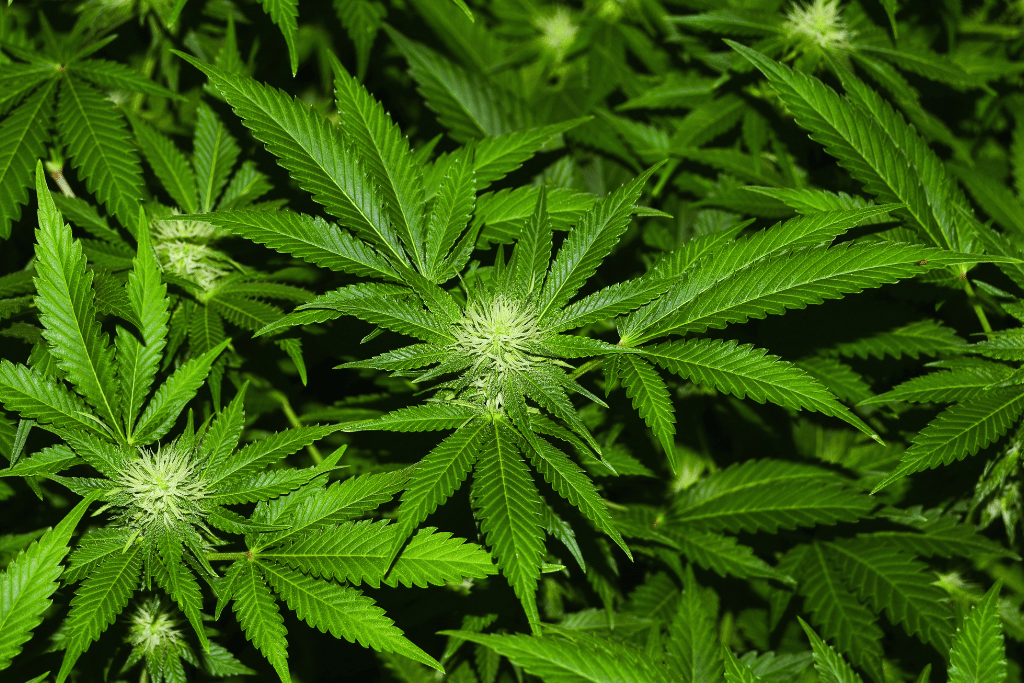
I don’t know about you, but I can’t get enough of these sneaky plants that try to look like our beloved Mary Jane. It’s like they are trying to be the cool kid on the block but aren’t quite pulling it off!
Don’t get me wrong; I’m not saying these plants aren’t cool in their own way. They are just like the wannabe rebels of the plant world. But hey, let’s give these plants some credit; they’re doing their best and have their own qualities too.
So, sit back, relax, and get ready to learn as we look closer at these plants that look like Mary Jane.
What does Mary Jane Look Like?
So, you want the low down on how to spot Mary Jane? Some key features make this herb stand out from the crowd. First off, the leaves are a giveaway. They are like the calling card of Cannabis.
Most strains have these jagged, pointy leaves that are a kind of star shape with five to seven points. Most strains are usually green but some cultivars are purple or reddish. It doesn’t stop there; you can spot Mary Jane a mile off from her buds. They are known as the jewel of the cannabis plant. These little flower clusters are what give the plant its potency and they are covered in these tiny hairs called trichomes.
Trichomes are what make the buds sticky and shiny, and they are packed with the psychoactive compound THC. Mary Jane has a pretty distinct aroma it’s like a skunky earthy mix, and it results from something called terpenes.
Terpenes are the essential oil of the plant world, giving cannabis its signature scent. With so many cannabis strains available nowadays, they can differ quite a bit. Some have wider leaves or buds that are a different color; others can vary in THC levels.
Spider Flower (Cleome hassleriana)
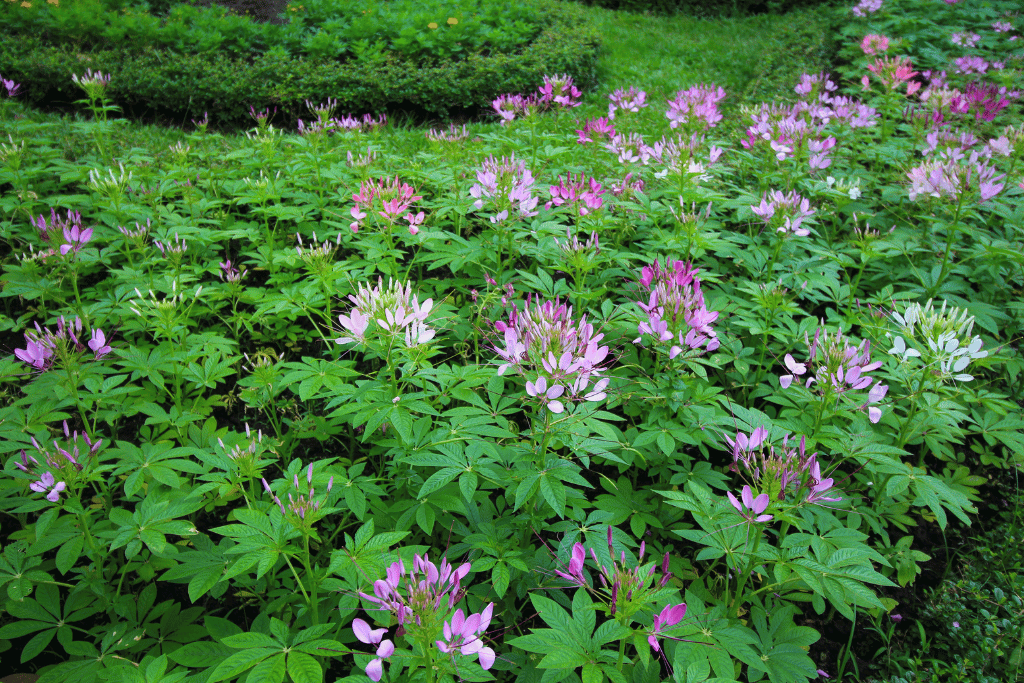
The first look-alike we have is the Spider flower, sometimes the Cleome plant. Both the leaves and the flowers of this plant resemble cannabis. The serrated palmate leaves are arranged in groups of three or five and have a pointed tip at the end of each leaflet.
The leaves of the Spider Flower are generally wider than cannabis and don’t have the same star-shaped pattern as cannabis leaves. The flowers of the cleome do contain small white hairs that look like trichomes however they are not psychoactive and won’t get you high. This South American native is found in gardens all around the world and is a hardy annual plant.
It has the capability of growing up to 6 feet tall and produces clusters of pink, purple or white flowers. Un like its Mary Jane look alike, the spider plant is not grown for its medicinal properties. Although the plant has been used topically in some cultures to treat minor wounds and skin irritations, I would seek advice from an expert before adding it to your herbal medicine cabinet.
Coral Plant (Jatropha multifida)
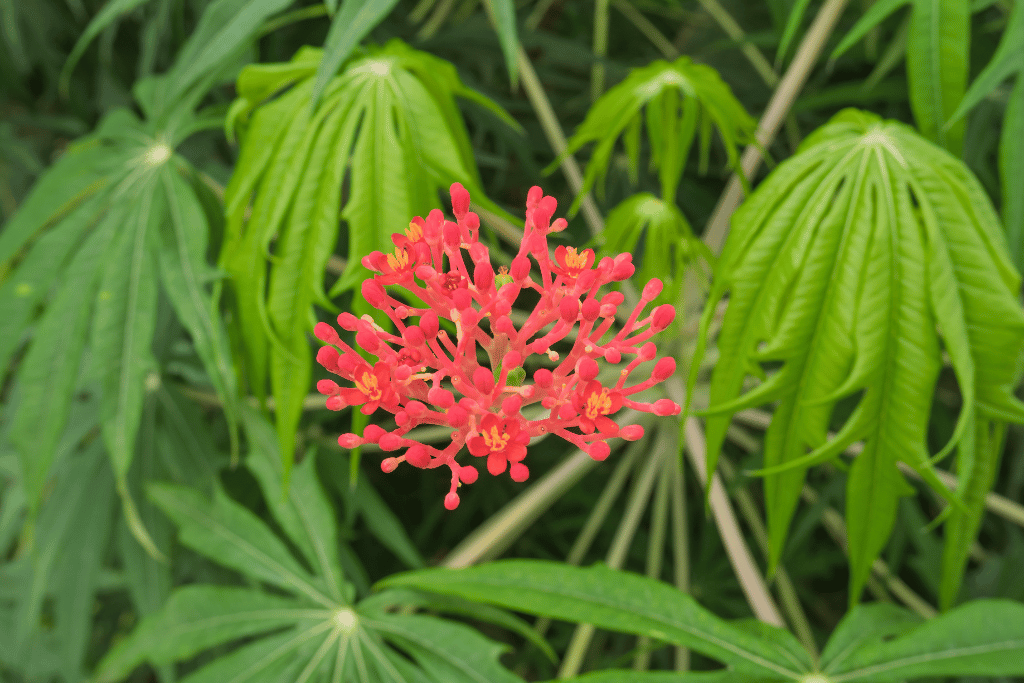
Next on the Mary Jane imposter list is the Coral Plant or Jatropha multifida as its scientifically known. Native to Mexico and the Caribbean, this plant’s foliage is one of the most convincing look-alikes out there.
The leaves have a similar shape and structure to Cannabis leaves, with serrated edges and pointed tips. However, one way to tell them apart is the Coral plant has a much thicker stem and more vibrant coral-colored flowers that turn heads.
The Coral plant isn’t just pretty to look at; it has several potential uses too. For one, the plant was used in some cultures to alleviate skin irritations and digestive issues. In addition to its medicinal properties (which are a far cry from the Mary Jane plant), the Coral plant is prized for its ornamental value. Its bright coral blooms are used in gardens and landscapes as a cover or border plant. These attractive blooms allure pollinators such as bees and butterflies, which is always a great sight in the garden.
Kenaf (Hibiscus cannabinus)
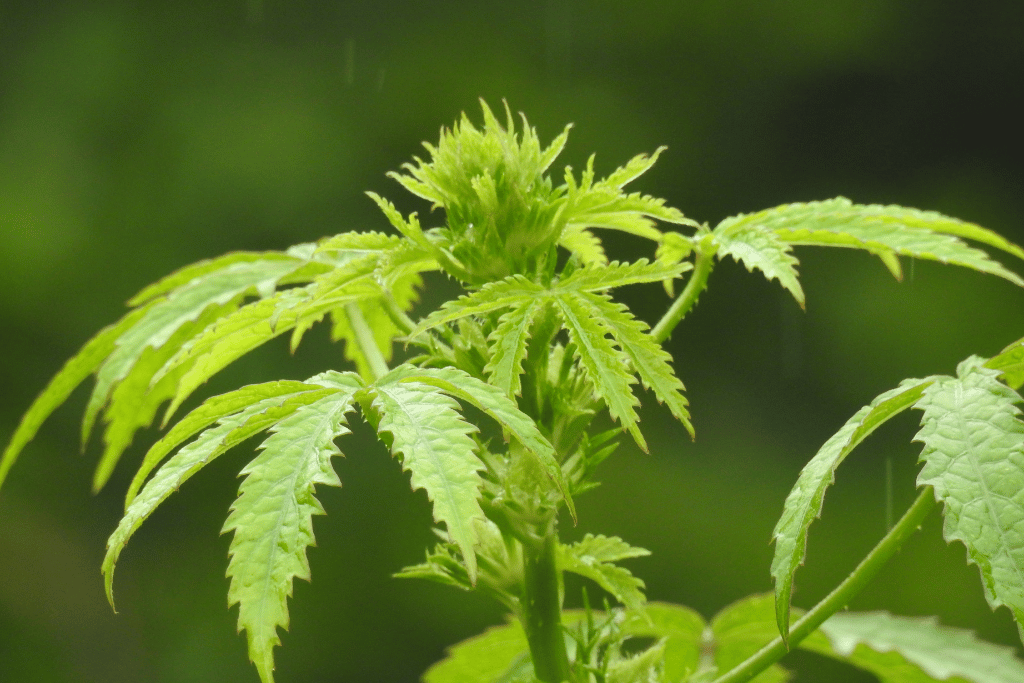
Moving on to Kenaf, also known as hibiscus cannabinus you can understand how it got its last name! I wasn’t going to add this one to the list because hibiccies are hibbicies right there’s no mistaking them… Wrong -This plant has leaves that look very similar to Mary Jane as they have the iconic serrated edge with five to seven pointy leaflets structured in a fan shape. One thing that sets the Kenaf apart from Mary jane is the blooms.
The blooms are typical of the hibiscus flower shape, which are very different from the Cannabis flowers. In regards to the uses of this plant, it does have some similarities to Cannabis, and that is that its fibers are used for weaving, making paper and textiles- similar to hemp, really.
In fact, some say kenaf fibers are as tough as nails! This versatile plant has been brewed as tea in the past too, it’s said that Kenaf tea aids digestion.
Japanese Maple (Acer palmatum)
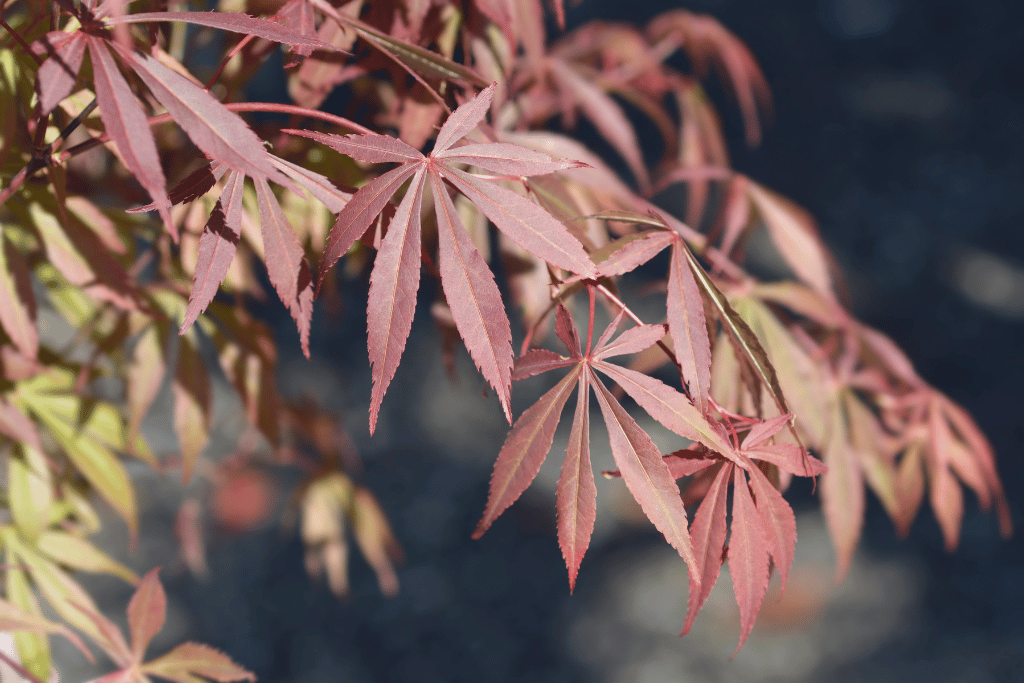
The next lookalikey we have is the Japanese Maple. I found out about these when I was looking for a plant I could bonsai- something about having a little Mary Jane tree seemed quite fun! While the leaves on this tree don’t resemble cannabis as closely as some of the others on this list, they have a similar shape and structure.
Japanese Maple leaves are deeply lobed and have serrated edges giving them a jagged appearance. The leaves are much larger and thicker than cannabis leaves and come in amazingly vibrant colors.
Some Japanese Maples are known to grow up to 25 feet tall, and others might just reach 6-8 feet. This slow-growing tree does hold some medicinal purposes but is nowhere near the same as Mary Jane. The Japanese Maple has been brewed as a tea in the past to treat a number of ailments. If you’re looking for a miniature Mary Jane tree to bonsai, the Japanese Maple is the best choice.
Chaste Tree (Vitex agnus- castus)

Chaste Tree is also known as Vitex and is one that I couldn’t help but notice around my local area. The leaves of the Chaste tree have the same fan shape as Mary Jane but are less serrated along the edges.
At first glance, I was fooled by this doppelganger, and it had me wondering if someone had dropped some seeds somewhere. After looking closer, I saw the difference. The flowers on this plant have a distinct look, with long thin petals that cluster together to form a cone-like shape.
The flowers have a similar shape and structure to some strains of Mary Jane, but they don’t carry the same psychoactive properties. Native to the Mediterranean region, it has been used for centuries for medicinal purposes. Some say the Chaste tree can help with various health issues, from PMS to menopause. It might sound like a lot to swallow, but some locals swear by it!
That’s not all; this robust shrub can be used as an ornamental plant. It reaches a great height of 20 feet, and its small clusters of purple flowers are great for attracting pollinators to the garden.
Cassava (Manihot esulenta)
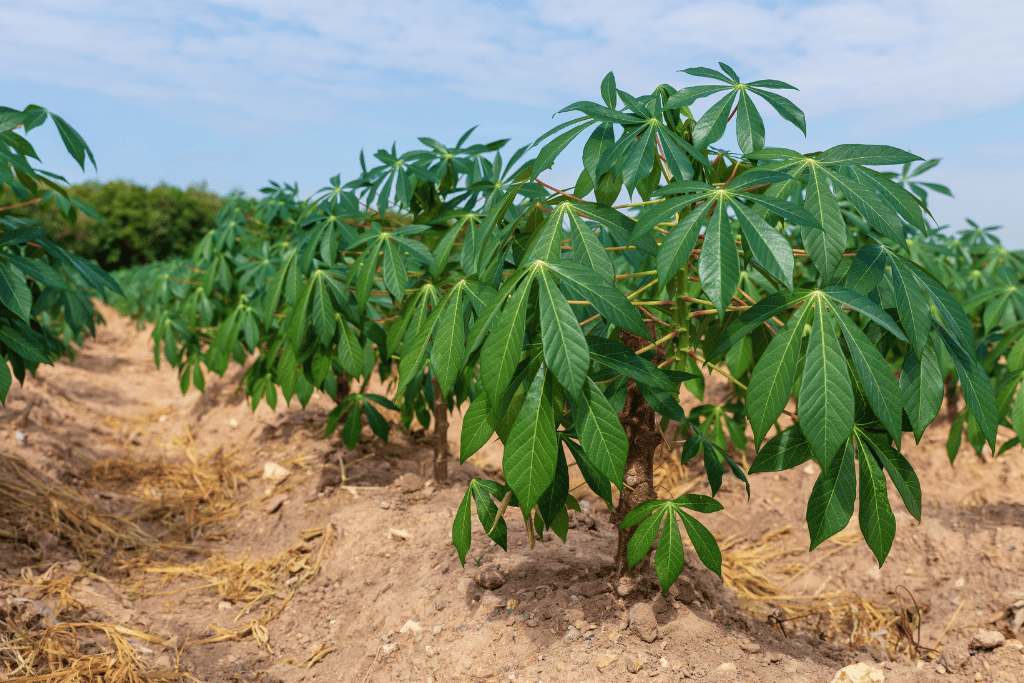
Casava has to be one of my favorite tropical plants. It produces an edible root that is a staple in many homes around the globe. Also known as Yuca, the leaves of this plant have a similar shape to Mary Jane with the fan shape, but they are a slightly fatter version. There is no serration on the edges of the leaves, but the stems of the Yuca do have a similar look with small white hairs that look like trichomes.
When you see this from a distance in the wild, you could easily mistake this for a Mary Jane plant there’s something about the way the leaves hang down that makes it look like Cannabis.
This plant has some surprising uses when it comes to the use of Cassava. The leaves of these plants have been used to make a natural insecticide that people swear by. And the plant’s root can be used to make biofuel by creating ethanol. It seems like a tall order, but Cassava could well be a viable alternative to fossil fuels.
Muster John Henry (Tagetes minuta)
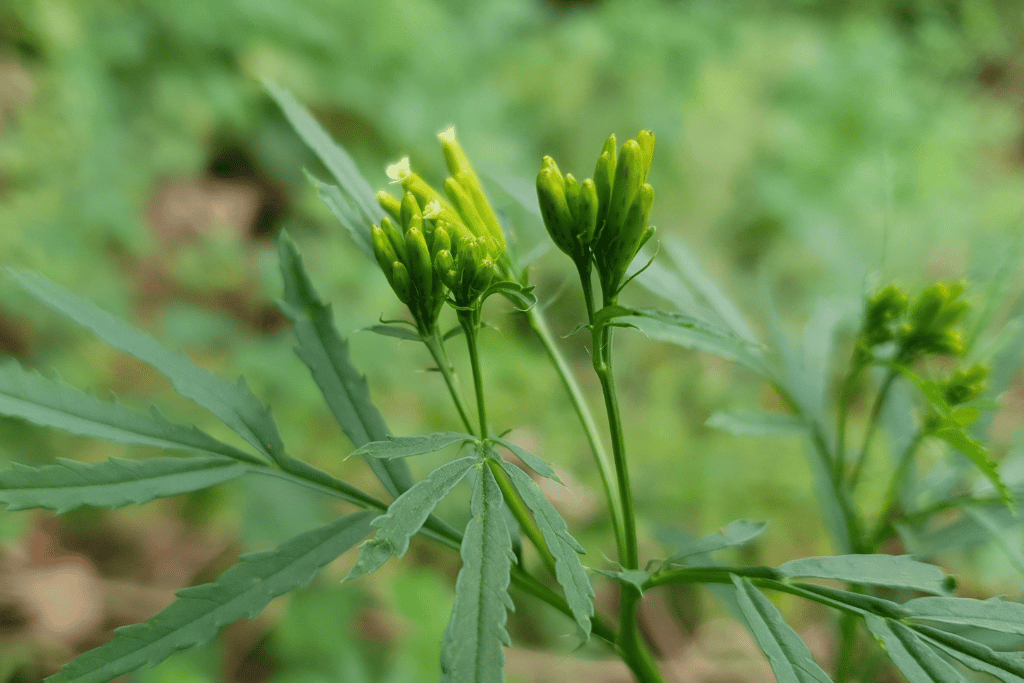
Last on the list of plants that look like Mary Jane is Muster John Henry or Jatropha Podgorica. This is the least convincing Mary Jane wannabe, but I put it on the list because the serrated leaves could trick you.
Muster John Henry has tall stalks and green serrated leaves, but if you take a closer look, you’ll see the leaves of this plant are actually broader and fatter than Mary Jane leaves. It might not be a dead ringer for cannabis, but it certainly can pass for it from a distance!
This tough plant is a native of the Southeastern United States and can grow in a variety of environments. It’s tolerant to heat and droughts and is often found growing wild in fields and along roadsides.
Unlike Mary Jane, Muster John Henry is not a psychoactive plant and doesn’t contain THC. Instead, it is often used for its fiber which can be made into rope twine and other materials. It might not be a cash cow like cannabis, but it can be put to good use!
One of my biggest curiosities about this plant is its very human name! This plant got its name because of its resemblance to hemp, which is called John Henry in the South. Muster meant to gather troops back in the 19th century, so the plant was likely found where soldiers had gathered.
From Doppelgangers to Disappointments!
So, there you have it- plants that look like our blessed Mary Jane. While all of these plants have some similarities to Cannabis, there are some major differences. None of these plants contain the compound THC or CBD which are responsible for their mind-altering effects.
But hey, that’s not necessarily a bad thing. These plants can still be an excellent addition to your garden or houseplant collection- especially without any legal or social consequences!
There are plenty out there if you’re looking for a plant that looks like Mary Jane. Just remember to appreciate them for what they are and not try to get high off them. After all, there’s nothing wrong with enjoying a little greenery without an altered state of mind!
FAQ About Plants That Look Like Mary Jane
What 5 leaf plant looks like Marijuanas?
The Chaste tree is a 5-leaf plant that holds the most resemblance to marijuana. The small shrub has 5 leaflets with serrated edges.
What do Marijuanas smell like?
Marijuana smelled earthy and skunk-like. Some may find the scent appealing, while others find it disgusting.
What does Marijuanas look like?
Marijuana is a mix of the cannabis plants’ foliage, including stems, seeds, and flowers. While it is illegal in some places, others use it for medicinal purposes.
How do I identify the plant I have?
To identify a plant, you need to note the following: Climate and region, stems, branches, leaf shape, and size, leaf arrangement, fruits and flowers, barbs hairs or thorns, fragrance, and root system. Research the details or use a plant finder application.



